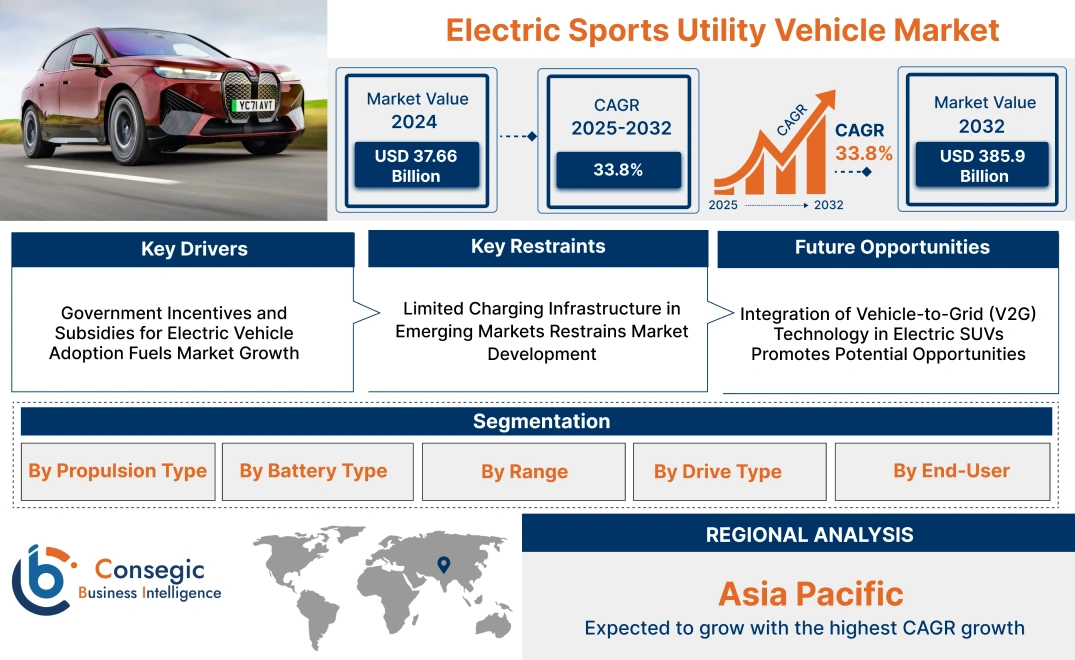- Summary
- Table Of Content
- Methodology
Electric Sports Utility Vehicle Market Size:
Electric Sports Utility Vehicle Market size is estimated to reach over USD 385.9 Billion by 2032 from a value of USD 37.66 Billion in 2024 and is projected to grow by USD 49.7 Billion in 2025, growing at a CAGR of 33.80% from 2025 to 2032.
Electric Sports Utility Vehicle Market Scope & Overview:
An electric sports utility vehicle (SUV) is a battery-powered vehicle designed to combine the features of traditional SUVs, such as spacious interiors, off-road capabilities, and versatile performance, with the environmental benefits of electric propulsion. These vehicles are equipped with advanced electric drivetrains, high-capacity batteries, and energy-efficient systems, providing superior range and performance while minimizing emissions. Electric SUVs also incorporate smart technologies, including regenerative braking, advanced driver-assistance systems (ADAS), and connected vehicle features, enhancing safety and user convenience.
Electric SUVs are available in various configurations, catering to different segments ranging from compact to full-size models. They are engineered using lightweight materials and aerodynamic designs to optimize energy efficiency and overall performance. Modern electric SUVs also emphasize comfort and luxury, integrating high-tech infotainment systems, customizable driving modes, and premium interior finishes.
End-users of electric SUVs include individual consumers, fleet operators, and ride-hailing service providers, who value the combination of performance, sustainability, and advanced technology these vehicles offer. With their versatility and innovation, electric SUVs continue to play a significant role in the evolving landscape of the automotive industry.
Electric Sports Utility Vehicle Market Dynamics - (DRO) :
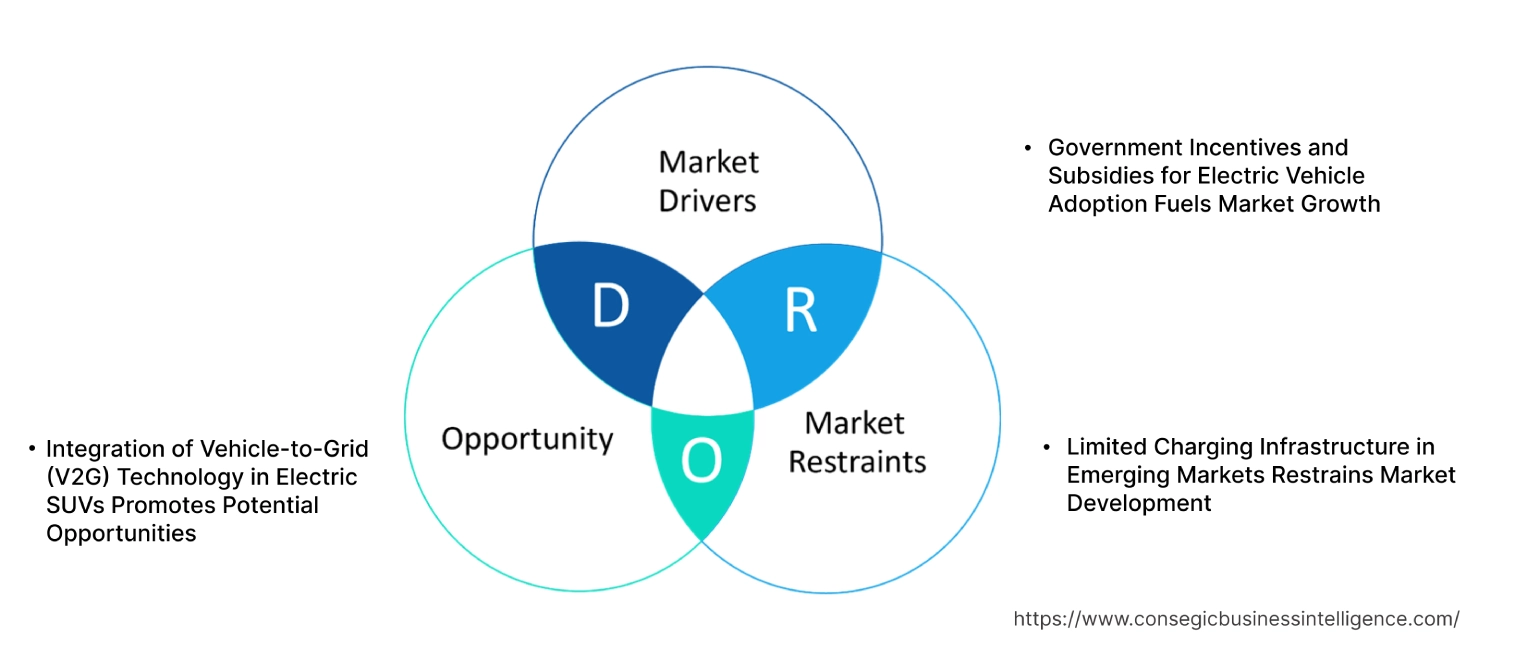
Key Drivers:
Government Incentives and Subsidies for Electric Vehicle Adoption Fuels Market Growth
The availability of government incentives and subsidies is accelerating the adoption of electric SUVs. Many governments offer tax rebates, reduced registration fees, and exemptions from tolls for electric vehicles, making them more affordable for consumers. Additionally, subsidies for the development of electric vehicle infrastructure and manufacturing capabilities encourage automakers to expand their electric SUV offerings. Such policies are particularly influential in markets like Europe, China, and North America, where governments aggressively promote clean energy vehicles, driving electric sports utility vehicle market growth.
Key Restraints :
Limited Charging Infrastructure in Emerging Markets Restrains Market Development
The lack of adequate charging infrastructure in emerging markets remains a significant barrier to the adoption of electric SUVs. While urban areas in developed regions are seeing rapid deployment of charging networks, rural and underserved regions lag behind, creating range anxiety among potential buyers. This challenge is compounded by the high costs associated with installing fast chargers, making it difficult for governments and private entities to achieve widespread coverage. The uneven distribution of charging infrastructure limits the usability of electric SUVs for long-distance travel in these regions, affecting electric sports utility vehicle market demand.
Future Opportunities :
Integration of Vehicle-to-Grid (V2G) Technology in Electric SUVs Promotes Potential Opportunities
The integration of vehicle-to-grid (V2G) technology into electric SUVs offers significant potential for market growth. V2G systems allow electric vehicles to function as mobile energy storage units, enabling bi-directional energy flow between the vehicle and the power grid. Electric SUVs equipped with V2G capabilities will provide backup power for homes during outages and support grid stability during peak demand. This technology aligns with the increasing emphasis on renewable energy integration and energy efficiency, making it an attractive feature for environmentally conscious buyers. Automakers focusing on V2G-enabled models will capitalize on electric sports utility vehicle market opportunities driven by the rising demand for sustainable mobility solutions.
Electric Sports Utility Vehicle Market Segmental Analysis :
By Propulsion Type:
Based on propulsion type, the market is segmented into Battery Electric Vehicle (BEV), Plug-In Hybrid Electric Vehicle (PHEV), and Fuel Cell Electric Vehicle (FCEV).
The Battery Electric Vehicle (BEV) segment accounted for the largest revenue of 68.30% in 2024.
- BEVs are fully electric vehicles, offering zero-emission solutions and benefiting from government incentives and subsidies globally.
- The increasing deployment of advanced charging infrastructure and the declining cost of lithium-ion batteries are key factors driving the adoption of BEVs.
- Leading manufacturers, such as Tesla, Rivian, and Mercedes-Benz, focus on expanding their BEV SUV portfolios to meet the rising consumer interest in sustainable vehicles.
- The dominance of the BEV segment reflects electric sports utility vehicle market expansion driven by eco-conscious consumer preferences and advancements in range and charging speed technologies.
The Fuel Cell Electric Vehicle (FCEV) segment is expected to register the fastest CAGR during the forecast period.
- FCEVs leverage hydrogen fuel cells to generate electricity, providing a longer range and faster refueling compared to BEVs.
- These vehicles are particularly suitable for heavy-duty and long-distance applications, catering to specific market segments like fleet operators and commercial users.
- Governments and organizations are investing in hydrogen infrastructure, boosting the adoption of FCEVs in specific regions.
- As per the electric sports utility vehicle market analysis, the rapid growth of the FCEV segment is driven by its potential to complement battery-based solutions in the electric SUV market.
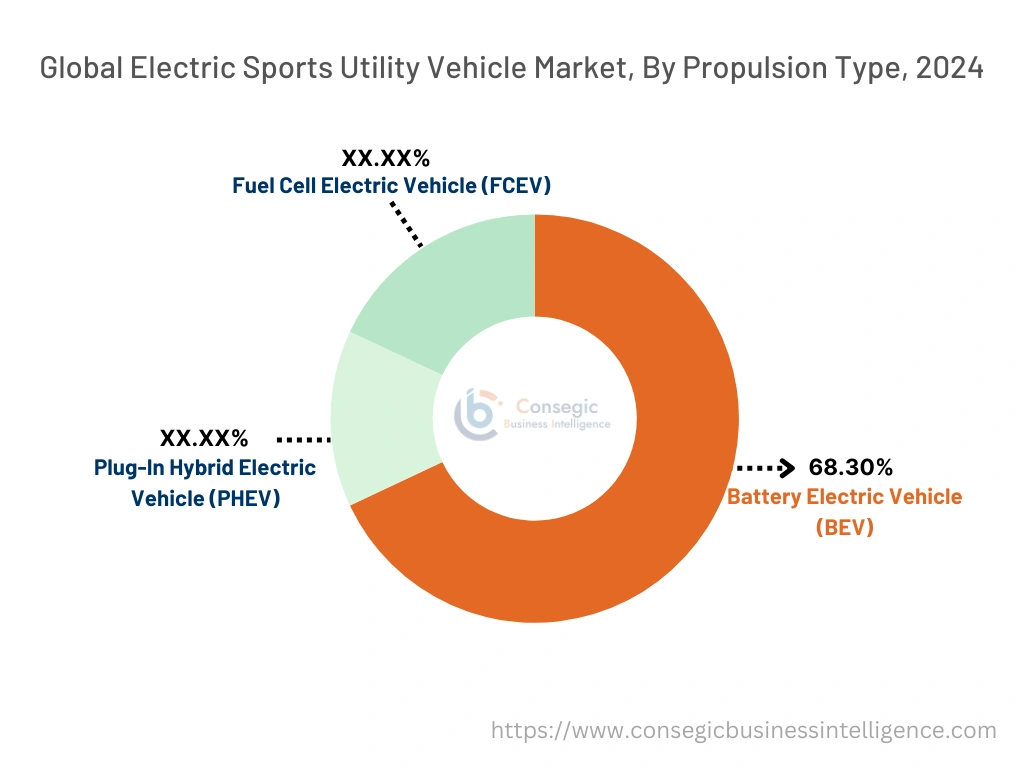
By Battery Type:
Based on battery type, the market is segmented into Lithium-Ion, Nickel-Metal Hydride, Solid-State, and Others.
The Lithium-Ion segment held the largest revenue of the total electric sports utility vehicle market share in 2024.
- Lithium-ion batteries dominate the electric SUV market due to their superior energy density, lightweight design, and long lifecycle.
- Automakers are investing heavily in improving the efficiency and safety of lithium-ion batteries, further enhancing their suitability for high-performance SUVs.
- The widespread use of lithium-ion technology in BEVs and PHEVs ensures its continued dominance across all regions.
- As per electric sports utility vehicle market trends, the segment's leadership is attributed to its extensive application in existing electric vehicles and continuous innovations in battery chemistry.
The Solid-State segment is expected to register the fastest CAGR during the forecast period.
- Solid-state batteries are the next frontier in battery technology, providing higher energy density, faster charging capabilities, and superior safety compared to conventional lithium-ion batteries.
- Automakers and battery manufacturers are intensifying research and development initiatives to make solid-state batteries commercially viable for electric SUVs by the end of the decade.
- The adoption of solid-state batteries is accelerating due to their ability to overcome critical barriers in electric vehicle adoption, including limited range and safety issues associated with traditional batteries.
- The segment's rapid progress highlights electric sports utility vehicle market growth, fueled by advancements in material science and increased investment in scalable manufacturing processes for solid-state technology.
By Range:
Based on range, the market is segmented into Up to 200 Miles, 200-400 Miles, and Above 400 Miles.
The 200-400 Miles segment accounted for the largest revenue share of the total electric sports utility vehicle market share in 2024.
- Electric SUVs with a range of 200-400 miles are highly preferred by consumers for their balance between affordability, practicality, and range reliability.
- This range caters to a wide audience, including daily commuters and long-distance travelers, offering versatility for multiple use cases.
- Technological advancements in energy storage systems and battery efficiency are enabling vehicles in this range to become more affordable and efficient.
- The dominance of the 200-400 miles segment reflects consumer preferences for mid-range electric SUVs that offer optimal performance without range anxiety, contributing to the electric sports utility vehicle market demand.
The Above 400 Miles segment is expected to register the fastest CAGR during the forecast period.
- SUVs with a range exceeding 400 miles are gaining significant traction among premium and long-distance vehicle buyers who prioritize high performance and extended travel capabilities.
- Leading automakers are introducing flagship electric SUVs equipped with large-capacity batteries and aerodynamically optimized designs to cater to this demand.
- Advancements in energy-dense battery technologies, such as solid-state batteries and next-generation lithium-ion cells, are enabling the development of long-range electric SUVs.
- The development of the 200-400 miles segment is fueled by rising consumer interest in long-distance travel solutions that offer both efficiency and comfort, contributing to electric sports utility vehicle market expansion.
By Drive Type:
Based on drive type, the market is segmented into 2WD, 4WD, and AWD.
The AWD segment dominated the market in 2024.
- AWD systems are critical for providing stability, traction, and control across various terrains and weather conditions, making them a preferred option in electric SUVs.
- Automakers are incorporating intelligent AWD systems with torque vectoring capabilities to optimize performance, delivering superior handling and a refined driving experience in premium and mid-range SUVs.
- The dominance of this segment is driven by the growing consumer preference for SUVs that combine off-road capabilities with enhanced safety features, catering to both urban and adventure-oriented users creating significant electric sports utility vehicle market opportunities.
The 4WD segment is expected to register the fastest CAGR during the forecast period.
- 4WD (Four-Wheel Drive) systems are widely used in rugged electric SUVs designed for off-road applications and challenging environments.
- Growth in adventure tourism and outdoor activities is driving the adoption of 4WD electric SUVs among enthusiasts and commercial operators.
- As per electric sports utility vehicle market analysis, the rapid progress of the 4WD segment is supported by its focus on durability and adaptability to extreme driving conditions.
By End-User:
Based on end-users, the market is segmented into Personal Use and Commercial Use (Ride-Hailing, Fleet Operators).
The Personal Use segment held the largest revenue share in 2024.
- Personal electric SUVs are highly favored by consumers for their versatility, spacious interiors, and superior performance compared to traditional passenger vehicles.
- Growing awareness about environmental sustainability and the cost benefits of lower maintenance and operational expenses are motivating individuals to transition from conventional SUVs to electric models.
- The segment’s dominance is attributed to the rising adoption of electric SUVs by families and individual buyers who prioritize eco-friendly transportation solutions and advanced vehicle features.
The Commercial Use segment is expected to register the fastest CAGR during the forecast period.
- Commercial applications, including ride-hailing services and fleet operations, are increasingly adopting electric SUVs for their cost-efficiency, reduced maintenance, and compliance with emission regulations.
- Companies like Uber and Lyft are transitioning their fleets to electric SUVs, leveraging their spacious designs and long-range capabilities.
- As per electric sports utility vehicle market trends, the rapid progress of the commercial use segment is supported by government incentives for fleet electrification and the growing focus on reducing carbon emissions in commercial transportation.
Regional Analysis:
The regions covered are North America, Europe, Asia Pacific, the Middle East and Africa, and Latin America.
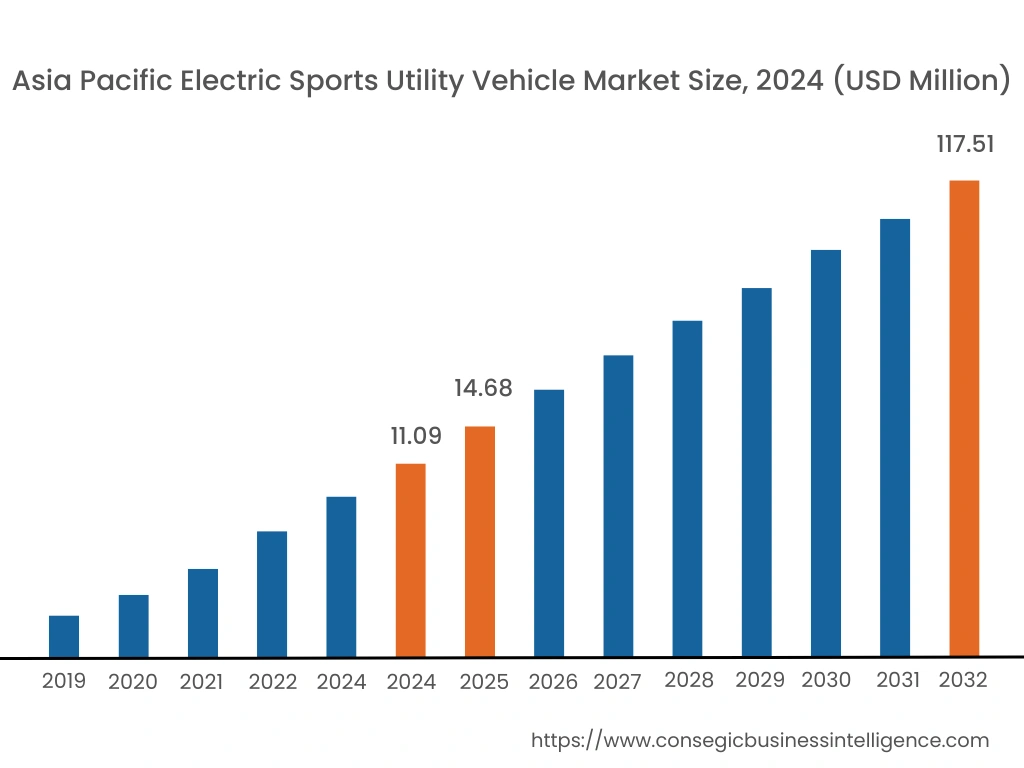
Asia Pacific region was valued at USD 11.09 Billion in 2024. Moreover, it is projected to grow by USD 14.68 Billion in 2025 and reach over USD 117.51 Billion by 2032. Out of these, China accounted for the largest share of 45.3% in 2024. Asia-Pacific is witnessing the fastest growth in the e-SUV market, driven by rapid industrialization and urbanization in countries like China, India, and Japan. The region has become a global hub for automotive production, with a strong emphasis on electric vehicles to combat pollution. The increasing investments in EV infrastructure and supportive government policies are further propelling market development.
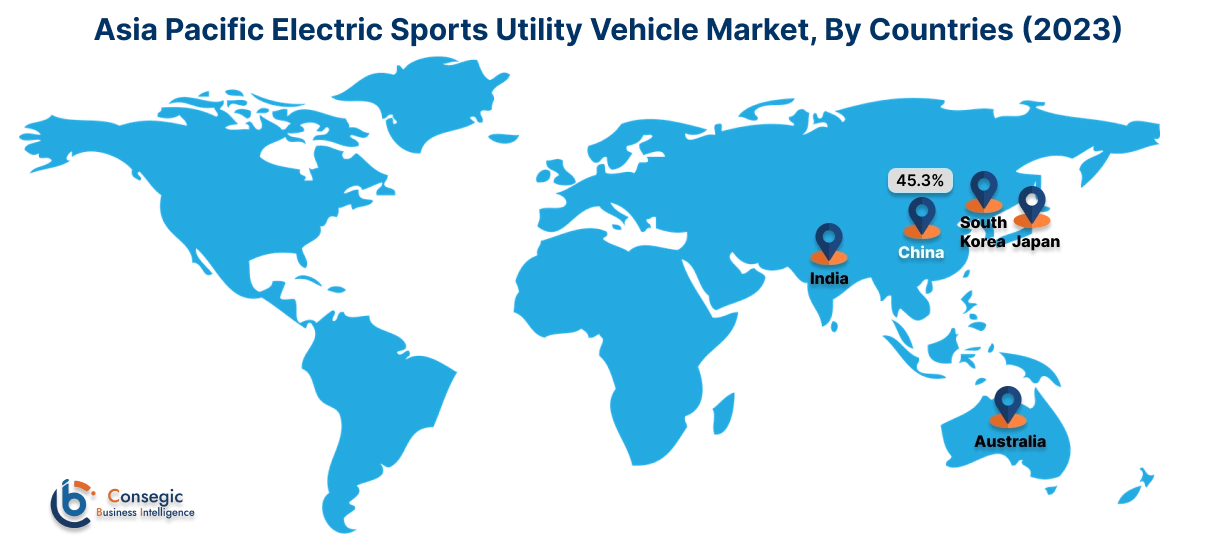
North America is estimated to reach over USD 125.07 Billion by 2032 from a value of USD 12.49 Billion in 2024 and is projected to grow by USD 16.45 Billion in 2025. North America holds a substantial share of the e-SUV market, primarily due to the robust automotive industry and high consumer demand for SUVs. The United States, in particular, leads the market with a strong presence of major automakers investing in electric models. The focus on reducing carbon emissions and government incentives for EV adoption have accelerated market progress.
Europe represents a significant portion of the global e-SUV market, with countries like Germany, France, and the United Kingdom leading in terms of adoption and innovation. The region benefits from stringent emission regulations and a strong emphasis on sustainability. The demand for electric vehicles is increasing, driven by government incentives and a growing charging infrastructure.
The Middle East & Africa region shows promising potential in the e-SUV market, particularly in countries like Saudi Arabia, the United Arab Emirates, and South Africa. Increasing investments in renewable energy and the expansion of the automotive sector are driving the demand for electric vehicles. The focus on diversifying economies and reducing dependence on oil revenues has led to progress in the EV market.
Latin America is an emerging market for e-SUVs, with Brazil and Mexico being the primary growth drivers. The rising adoption of electric vehicles, improving infrastructure, and increasing focus on sustainability contribute to the market's expansion. Government initiatives aimed at reducing carbon emissions and promoting clean energy are supporting market development.
Top Key Players & Market Share Insights:
The Electric Sports Utility Vehicle market is highly competitive with major players providing products and services to the national and international markets. Key players are adopting several strategies in research and development (R&D), product innovation, and end-user launches to hold a strong position in the global Electric Sports Utility Vehicle market. Key players in the Electric Sports Utility Vehicle industry include –
- Tesla, Inc. (USA)
- Rivian Automotive, Inc. (USA)
- Lucid Motors, Inc. (USA)
- BYD Company Limited (China)
- NIO Inc. (China)
- XPeng Inc. (China)
- Volkswagen AG (Germany)
- BMW AG (Germany)
- Ford Motor Company (USA)
- General Motors Company (USA)
Recent Industry Developments :
Partnerships & Collaborations:
- In February 2024, Volkswagen partnered with XPENG to co-develop two smart electric vehicles targeting the Chinese market, as part of its strategy to strengthen its EV lineup. The collaboration focuses on integrating XPENG's software and autonomous driving technologies into Volkswagen’s designs, aiming for rapid product development and market entry by 2026. This initiative aligns with Volkswagen's broader push to expand its presence in China’s competitive EV sector.
Product Launches:
- In November 2024, Hyundai unveiled the IONIQ 9, a spacious and innovative electric SUV designed to redefine EV mobility. The vehicle combines cutting-edge technology with ample interior space, emphasizing sustainability and user-centric design. Key highlights include advanced connectivity features, enhanced battery performance, and futuristic styling, positioning the IONIQ 9 as a standout in the electric SUV market. The model underscores Hyundai’s commitment to leading EV innovation globally.
- In August 2023, Acura unveiled the all-electric 2024 ZDX and ZDX Type S SUVs, showcasing sleek designs, advanced technology, and impressive performance. These models mark Acura's entry into the EV segment, with features such as a precision EV driving experience and luxurious interiors. The ZDX Type S emphasizes high performance, while both variants offer long-range capabilities and fast charging.
Electric Sports Utility Vehicle Market Report Insights :
| Report Attributes | Report Details |
| Study Timeline | 2019-2032 |
| Market Size in 2032 | USD 385.9 Billion |
| CAGR (2025-2032) | 33.8% |
| By Propulsion Type |
|
| By Battery Type |
|
| By Range |
|
| By Drive Type |
|
| By End-User |
|
| By Region |
|
| Key Players |
|
| North America | U.S. Canada Mexico |
| Europe | U.K. Germany France Spain Italy Russia Benelux Rest of Europe |
| APAC | China South Korea Japan India Australia ASEAN Rest of Asia-Pacific |
| Middle East and Africa | GCC Turkey South Africa Rest of MEA |
| LATAM | Brazil Argentina Chile Rest of LATAM |
| Report Coverage |
|
Key Questions Answered in the Report
How big is the Electric Sports Utility Vehicle market? +
Electric Sports Utility Vehicle Market size is estimated to reach over USD 385.9 Billion by 2032 from a value of USD 37.66 Billion in 2024 and is projected to grow by USD 49.7 Billion in 2025, growing at a CAGR of 33.80% from 2025 to 2032.
What specific segmentation details are covered in the Electric Sports Utility Vehicle Market report? +
The Electric Sports Utility Vehicle market report includes segmentation details for propulsion type (Battery Electric Vehicle (BEV), Plug-In Hybrid Electric Vehicle (PHEV), Fuel Cell Electric Vehicle (FCEV)), battery type (Lithium-Ion, Nickel-Metal Hydride, Solid-State, Others), range (Up to 200 Miles, 200-400 Miles, Above 400 Miles), drive type (2WD, 4WD, AWD), end-user (Personal Use, Commercial Use), and region.
Which is the fastest-growing segment in the Electric Sports Utility Vehicle market? +
The Fuel Cell Electric Vehicle (FCEV) segment is expected to register the fastest CAGR during the forecast period, driven by its potential for long-range and fast refueling capabilities.
Who are the major players in the Electric Sports Utility Vehicle market? +
The major players in the Electric Sports Utility Vehicle market include Tesla, Inc. (USA), Rivian Automotive, Inc. (USA), Lucid Motors, Inc. (USA), BYD Company Limited (China), NIO Inc. (China), XPeng Inc. (China), Volkswagen AG (Germany), BMW AG (Germany), Ford Motor Company (USA), and General Motors Company (USA).
